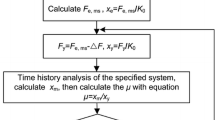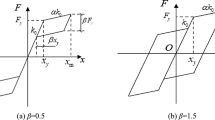Abstract
Structures located in seismically active regions may be subjected to mainshock-aftershock (MSAS) sequences. Strong aftershocks significantly affect the hysteretic energy demand of structures. The hysteretic energy, EH,seq, is normalized by mass m and expressed in terms of the equivalent velocity, VD,seq, to quantitatively investigate aftershock effects on the hysteretic energy of structures. The equivalent velocity, VD,seq, is computed by analyzing the response time-history of an inelastic single-degree-of-freedom (SDOF) system with a varying vibration period subjected to 309 MSAS sequences. The present study selected two kinds of MSAS sequences, with one aftershock and two aftershocks, respectively. The aftershocks are scaled to maintain different relative intensities. The variation of the equivalent velocity, VD,seq, is studied for consideration of the ductility values, site conditions, relative intensities, number of aftershocks, hysteretic models, and damping ratios. The MSAS sequence with one aftershock exhibited a 10% to 30% hysteretic energy increase, whereas the MSAS sequence with two aftershocks presented a 20% to 40% hysteretic energy increase. Finally, a hysteretic energy prediction equation is proposed as a function of the vibration period, ductility value, and damping ratio to estimate hysteretic energy for mainshock-aftershock sequences.
Similar content being viewed by others
References
Akiyama H (1985), Earthquake-Resistant Limit State Design for Buildings, University of Tokyo Press.
Amiri GG, Darzi GA and Amiri JV (2008), “Design Elastic Input Energy Spectra Based on Iranian Earthquakes,” Canadian Journal of Civil Engineering, 35(6): 635–646.
Arroyo D and Ordaz M (2007a), “Hysteretic Energy Demands for SDOF Systems Subjected to Narrow Band Earthquake Ground Motions. Applications to the Lake Bed Zone of Mexico City,” Journal of Earthquake Engineering, 11(2): 147–165.
Arroyo D and Ordaz M (2007b), “On the Estimation of Hysteretic Energy Demands for SDOF Systems,” Earthquake Engineering and Structural Dynamics, 36(15): 2365–2382.
Augenti N and Parisi F (2010), “Learning from Construction Failures due to the 2009 L’Aquila, Italy, Earthquake,” Journal of Performance of Constructed Facilities, 24(6): 536–555.
Ay BÖ and Akkar S (2012), “A Procedure on Ground Motion Selection and Scaling for Nonlinear Response of Simple Structural Systems,” Earthquake Engineering and Structural Dynamics, 41(12): 1693–1707.
Baker JW (2010), “Conditional Mean Spectrum: Tool for Ground-motion Selection,” Journal of Structural Engineering, 137(3): 322–331.
Baker JW and Allin Cornell C (2006), “Spectral Shape, Epsilon and Record Selection,” Earthquake Engineering and Structural Dynamics, 35(9): 1077–1095.
Bates DM and Watts DG (1988), Nonlinear Regression Analysis and Its Applications, Wiley, New York.
Benavent-Climent A, López-Almansa F and Bravo-González DA (2010), “Design Energy Input Spectra for Moderate-to-high Seismicity Regions Based on Colombian Earthquakes,” Soil Dynamics and Earthquake Engineering, 30(11): 1129–1148.
Benavent-Climent A, Pujades LG and López-Almansa F (2002), “Design Energy Input Spectra for Moderateseismicity Regions,” Earthquake Engineering and Structural Dynamics, 31(5): 1151–1172.
Bojórquez E, Reyes-Salazar A, Terán-Gilmore A and Ruiz SE (2010), “Energy-Based Damage Index for Steel Structures,” Steel and Composite Structures, 10(4): 343–360.
Bojórquez E, Ruiz SE and Terán-Gilmore A (2008), “Reliability-Based Evaluation of Steel Structures using Energy Concepts,” Engineering Structures, 30(6): 1745–1759.
Boore DM (1993), “Some Notes Concerning the Determination of Shear-wave Velocity and Attenuation,” Proceedings of Geophysical Techniques for Site and Material Characterization, 129–134.
Ceci AM, Contento A, Fanale L, Galeota D, Gattulli V, Lepidi M and Potenza F (2010), “Structural Performance of the Historic and Modern Buildings of the University of L’Aquila During the Seismic Events of April 2009,” Engineering Structures, 32(7): 1899–1924.
CEN (2003), Eurocode 8: Design of Structures for Earthquake Resistance, part 1: General Rules, Seismic Actions and Rules for Buildings, European Committee for Standardization, Brussels.
CENC (2008), China Earthquake Networks Center, (http://data.earthquake.cn and http://www.csndmc. ac.cn).
Chai YH and Fajfar P (2000), “A Procedure for Estimating Input Energy Spectra for Seismic Design,” Journal of Earthquake Engineering, 4(4): 539–561.
Chai YH, Fajfar P and Romstad KM (1998), “Formulation of Duration-Dependent Inelastic Seismic Design Spectrum,” Journal of Structural Engineering, 124(8): 913–921.
Chai YH, Romstad KM and Bird SM (1995), “Energy-Based Linear Damage Model for High-Intensity Seismic Loading,” Journal of Structural Engineering,121(5): 857–864.
Choi H and Kim J (2006), “Energy-Based Seismic Design of Buckling-Restrained Braced Frames using Hysteretic Energy Spectrum,” Engineering Structures, 28(2): 304–311.
Decanini LD and Mollaioli F (1998), “Formulation of Elastic Earthquake Input Energy Spectra,” Earthquake Engineering and Structural Dynamics, 27(12): 1503–1522.
Decanini LD and Mollaioli F (2001), “An Energy-Based Methodology for the Assessment of Seismic Demand,” Soil Dynamics and Earthquake Engineering, 21(2): 113–137.
Dindar AA, Yalçın C, Yüksel E, Özkaynak H and Büyüköztürk O (2015), “Development of Earthquake Energy Demand Spectra,” Earthquake Spectra, 31(3): 1667–1689.
Di Sarno L (2013), “Effects of Multiple Earthquakes on Inelastic Structural Response,” Engineering Structures, 54: 673–681.
Di Sarno L, Yenidogan C and Erdik M (2013), “Field Evidence and Numerical Investigation of the MW = 7.1 October 23 Van, Tabanlı and the MW > 5.7 November Earthquakes of 2011,” Bulletin of Earthquake Engineering, 11(1): 313–346.
Dong Y and Frangopol DM (2015), “Risk and Resilience Assessment of Bridges under Mainshock and Aftershocks Incorporating Uncertainties,” Engineering Structures 83: 198–208.
Faisal A, Majid TA and Hatzigeorgiou GD (2013), “Investigation of Story Ductility Demands of Inelastic Concrete Frames Subjected to Repeated Earthquakes,” Soil Dynamics and Earthquake Engineering, 44: 42–53.
Fajfar P and Vidic T (1994), “Consistent Inelastic Design Spectra: Hysteretic and Input Energy,” Earthquake Engineering and Structural Dynamics, 23(5): 523–537.
GEER (2016), Geotechnical Extreme Events Reconnaissance, (http://geerassociation.org/component/geer_reports /?view=geerreports&id=76&layout=defau lt).
Goda K (2012), “Nonlinear Response Potential of Mainshock-Aftershock Sequences from Japanese Earthquakes,” Bulletin of the Seismological Society of America, 102(5): 2139–2156.
Goda K and Taylor CA (2012), “Effects of Aftershocks on Peak Ductility Demand Due to Strong Ground Motion Records from Shallow Crustal Earthquakes,” Earthquake Engineering and Structural Dynamics, 41(15): 2311–2330.
Gong Y, Xue Y, Xu L and Grierson DE (2012), “Energy-Based Design Optimization of Steel Building Frameworks Using Nonlinear Response History Analysis,” Journal of Constructional Steel Research, 68(1): 43–50.
Hatzigeorgiou GD (2010a), “Behavior Factors for Nonlinear Structures Subjected to Multiple Near-Fault Earthquakes,” Computers and Structures, 88(5-6): 309–321.
Hatzigeorgiou GD (2010b), “Ductility Demand Spectra for Multiple Near-And Far-Fault Earthquakes,” Soil Dynamics and Earthquake Engineering, 30(4): 170–183.
Hatzigeorgiou GD and Liolios AA (2010), “Nonlinear Behaviour of RC Frames under Repeated Strong Ground Motions,” Soil Dynamics and Earthquake Engineering, 30(10): 1010–1025.
Housner GW (1956), “Limit Design of Structures to Resist Earthquakes,” Proceedings of First World Conference on Earthquake Engineering, 5: 1–12.
International Building Code (IBC) (2006), International Code Council Inc., 4051 West Flossmoor Road, Country Club Hills.
Jeon JS, DesRoches R, Lowes LN and Brilakis I (2015), “Framework of Aftershock Fragility Assessment–Case Studies: Older California Reinforced Concrete Building Frames,” Earthquake Engineering and Structural Dynamics, 44(15): 2617–2636.
Kam WY, Pampanin S and Elwood K (2011), “Seismic Performance of Reinforced Concrete Buildings in the 22 February Christchurch (Lyttelton) Earthquake,” Bulletin of the New Zealand Society for Earthquake Engineering, 44(4): 239–278.
Katsanos EI, Sextos AG, and Manolis GD (2010), “Selection of Earthquake Ground Motion Records: A State-of-the-Art Review From A Structural Engineering Perspective,” Soil Dynamics and Earthquake Engineering, 30(4): 157–169.
Kunnath SK, Reinhorn AM and Park YJ (1990), “Analytical Modeling of Inelastic Seismic Response of R/C Structures,” Journal of Structural Engineering, 116(4): 996–1017.
Kunnath SK, Reinhorn AM and Lobo RF (1992), “IDARC Version3.0: A Program For the Inelastic Damage Analysis of Reinforced Concrete Structures,” Technical Report No. NCEER-92-0022, National Center for Earthquake Engineering Research, State University of New York, Buffalo.
Kuwamura H and Galambos TV (1989), “Earthquake Load for Structural Reliability,” Journal of Structural Engineering, 115(6): 1446–1462.
Kyoshin-Net (2009), National Research Institute for Earth Science and Disaster Resilience, http://www. kyoshin.bosai.go.jp.
López-Almansa F, Yazgan AU and Benavent-Climent A (2013), “Design Energy Input Spectra for High Seismicity Regions Based on Turkish Registers,” Bulletin of Earthquake Engineering, 11(4): 885–912.
Manfredi G (2001), “Evaluation of Seismic Energy Demand,” Earthquake Engineering and Structural Dynamics, 30(4): 485–499.
Miranda E and Ruiz-Garcia J (2002), “Influence of Stiffness Degradation on Strength Demands of Structures Built on Soft Soil Sites,” Engineering Structures, 24(10): 1271–1281.
Moustafa A and Takewaki I (2010), “Modeling Critical Ground-Motion Sequences for Inelastic Structures,” Advances in Structural Engineering, 13(4): 665–680.
Moustafa A and Takewaki I (2011), “Response of Nonlinear Single-Degree-of-Freedom Structures to Random Acceleration Sequences,” Engineering Structures, 33(4): 1251–1258.
Nazari N, van de Lindt JW and Li Y (2013), “Effect of Mainshock-Aftershock Sequences on Woodframe Building Damage Fragilities,” Journal of Performance of Constructed Facilities, 29(1): 04014036.
Rahnama M and Krawinkler H (1993), “Effects of Soft Soil And Hysteresis Model On Seismic Demands,” John A. Blume Earthquake Engineering Center, chapter 3, pp 36–37.
Riddell R and Garcia JE (2001), “Hysteretic Energy Spectrum and Damage Control,” Earthquake Engineering and Structural Dynamics, 30(12): 1791–1816.
Ruiz-García J and Negrete-Manriquez JC (2011), “Evaluation of Drift Demands in Existing Steel Frames under As-Recorded Far-Field and Near-Fault Mainshockaftershock Seismic Sequences,” Engineering Structures, 33(2): 621–634.
Uang CM and Bertero VV (1990), “Evaluation of Seismic Energy in Structures,” Earthquake Engineering and Structural Dynamics, 19(1): 77–90.
Zahrah TF and Hall WJ (1982), Seismic Energy Absorption in Simple Structures, Structural Research Series no. 501, University of Illinois, Urbana.
Zhai CH, Ji DF, Wen WP, Lei WD, Xie LL and Gong MS (2016), “The Inelastic Input Energy Spectra for Main Shock–Aftershock Sequences,” Earthquake Spectra, 32(4): 2149–2166.
Zhai CH, Wen WP, Chen ZQ, Li S and Xie LL (2013a), “Damage Spectra for the Mainshock-Aftershock Sequence-Type Ground Motions,” Soil Dynamics and Earthquake Engineering, 45: 1–12.
Zhai CH, Wen WP, Li S and Xie LL (2014), “The Damage Investigation of Inelastic SDOF Structure under the Mainshock-Aftershock Sequence-Type Ground Motions,” Soil Dynamics and Earthquake Engineering, 59: 30–41.
Zhai CH, Wen WP, Li S and Xie LL (2015), “The Ductility-Based Strength Reduction Factor for the Mainshock-aftershock Sequence-type Ground Motions,” Bulletin of Earthquake Engineering, 13(10): 2893–2914.
Zhai CH, Wen WP, Zhu TT, Li S and Xie LL (2013b), “Inelastic Displacement Ratios for Design of Structures with Constant Damage Performance,” Engineering Structures, 52: 53–63.
Acknowledgement
This investigation is supported by the National Key R&D Program of China (2017YFC1500602, 2016YFC0701108), the National Natural Science Foundation of China (No. 51322801, 51708161), the Outstanding Talents Jump Promotion Plan of Basic Research of Harbin Institute of Technology, China Postdoctoral Science Foundation (No. 2016M601430). These supports are greatly appreciated.
Author information
Authors and Affiliations
Corresponding author
Additional information
Supported by: National Key R&D Program of China under Grant No. 2017YFC1500602 and 2016YFC0701108, the National Natural Science Foundation of China under Grant No. 51322801 and 51708161, the Outstanding Talents Jump Promotion Plan of Basic Research of Harbin Institute of Technology, China Postdoctoral Science Foundation under Grant No. 2016M601430
Rights and permissions
About this article
Cite this article
Zhai, C., Ji, D., Wen, W. et al. Hysteretic energy prediction method for mainshock-aftershock sequences. Earthq. Eng. Eng. Vib. 17, 277–291 (2018). https://doi.org/10.1007/s11803-018-0441-1
Received:
Accepted:
Published:
Issue Date:
DOI: https://doi.org/10.1007/s11803-018-0441-1




